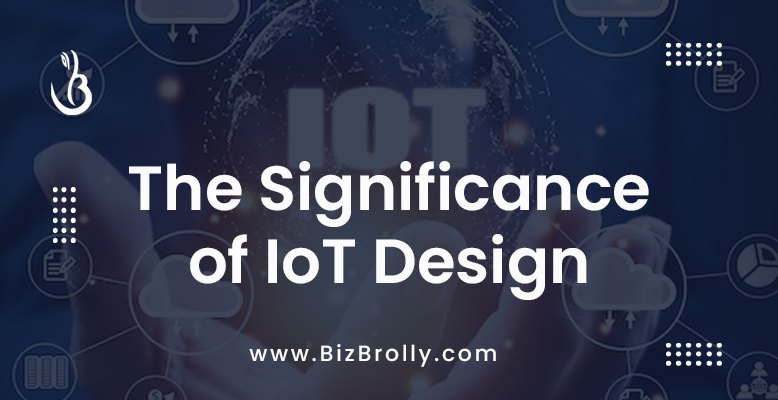
The Internet of Things (IoT) is a network of physical objects or “things” that are equipped with sensors, software, and other technologies to enable internet-based data sharing and communication with other systems or devices. From basic home appliances like smart thermostats and refrigerators to sophisticated industrial machinery used in production or transportation, these connected devices can be anything. IoT’s ultimate objective is to build a network of interconnected devices that can talk to one another, exchange data, and be remotely controlled or monitored. This will boost efficiency, productivity, and convenience. The way we live, work, and interact with the physical environment could all be drastically altered by this connection.In this blog we will explore the importance of IoT design and how a custom software development company can help in this.
The success and efficiency of IoT (Internet of Things) systems depend greatly on their design. IoT systems and devices are networked and produce a lot of data, which needs to be processed and analysed instantly in order to make wise decisions. IoT systems that are poorly built may have security flaws, device problems, and incorrect data processing. Therefore, it is crucial to take the following factors into account while designing an IoT system:
Depending on the amount of data created and the number of connected devices, IoT systems should be able to scale up or down.
IoT systems are vulnerable to security threats and vulnerabilities such as data breaches, virus attacks, and unauthorized access. Therefore, strong security mechanisms like data encryption, access control, and device authentication should be incorporated into the design.
It might be difficult to combine IoT devices from many manufacturers into a single system since they may use several protocols and standards. Therefore, interoperability should be taken into account in IoT design to ensure smooth data transfer and communication between devices.
The IoT system should be designed with the user’s needs in mind, making it simple to use, intuitive, and available to a variety of users.
To prolong the battery life, IoT devices frequently operate on batteries and minimize power consumption. Provide long battery life and lower maintenance costs, the design should optimise power utilisation.
IoT devices connect securely with the cloud and with one another. To ensure unauthorized access prevention, it is crucial to encrypt and authenticate these communications.
Information should be shielded from unauthorised access whether it is kept on IoT devices or in the cloud. Access controls and encryption can help with this.
IoT devices and data should only be accessible to authorised people. To ensure that only authorised users can access the system, authentication and authorisation procedures should be put in place.
Physical attacks are a possibility for IoT devices. Therefore, it’s crucial to have physical security measures in place to stop tampering or unauthorised access.
IoT devices may gather personal data about users. As a result, it’s crucial to preserve privacy by anonymizing or encrypting data and putting in place sensible access limits.
The success and efficiency of an IoT system can be significantly impacted by two key elements of IoT design: scalability and interoperability.
The ability of an IoT system to accommodate growing data and device volumes as it expands in size and complexity is referred to as scalability. Without incurring performance loss or necessitating substantial alterations to the underlying architecture, a scalable IoT system should be able to handle new gadgets, sensors, and data sources.
Interoperability means that different devices can work together seamlessly, regardless of their manufacturer, protocol, or technology. An interoperable IoT system should be able to integrate with different types of devices, platforms, and networks, and enable data sharing and communication across multiple domains.
To achieve scalability and interoperability in IoT design, you can use several ways such as:
To ensure compatibility between various devices and platforms, IoT devices should communicate using standardised protocols like MQTT, CoAP, or HTTP.
Building IoT systems with discrete components that can be modified, deleted, or added in a modular manner without affecting the system enables scalability and simple integration of additional hardware and data sources.
Scalable, adaptable, and interoperable platforms for IoT data processing, analysis, and storage can be found with cloud-based services like Amazon Web Services (AWS) or Microsoft Azure.
Open standards like OCF, OneM2M, or OPC UA enhance interoperability by enabling various devices and systems to communicate with each other using standard interfaces and data models.
Incorporate strong security measures into IoT systems to guard against unauthorized access, data breaches, and cyber-attacks, and do not sacrifice security in favor of scalability or interoperability.
The continued development of technology and the rising demand for linked devices make the future of IoT design look promising. Users will experience more seamless and individualized experiences with increasingly advanced and intelligent IoT gadgets. Integration of artificial intelligence and machine learning algorithms into IoT systems is one of the notable themes. In the future, IoT architecture is expected to be influenced. IoT designers will prioritize building stronger and secure systems to prevent hacking and cyberattacks. Enable devices to understand and adjust to user behavior and preferences.
BizBrolly is an IT consulting and software development company, specialising in IoT design. We can assist you with the entire IoT design process, from ideation to deployment. Our team of skilled IoT professionals can help you develop custom IoT solutions that meet your specific business requirements. We can provide end-to-end services, including hardware design, software development, cloud integration, and analytics. BizBrolly’s expertise in IoT design can help you create innovative and scalable solutions that can enhance your business operations.